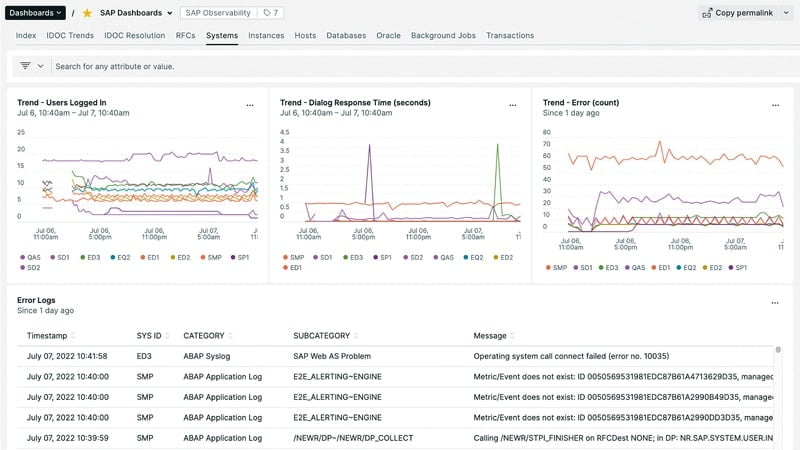See what happens


Why native observability is becoming important for SAP developers
Enterprises increasingly rely on a mix of microservices-based software, this is often developed in-house and combines several standard software components from leading ISVs such as e-commerce, CRM or ERP. Business processes span an ever-increasing number of software endpoints. And if a problem occurs at one endpoint, it can impact the entire business process - with consequences for revenue, costs and customer satisfaction.
The SAP software collection in particular is often used to manage central business areas such as procurement, production planning, financial management or sales. Due to their strategic importance and complexity, SAP systems are usually managed independently by separate teams in silos. But any problem in the SAP architecture can impact end-to-end business processes and other external software components that depend on SAP upstream or downstream.
When a problem occurs in an SAP system, it can take significant time to detect it (Mean Time to Detect), assign the problem to SAP, find the root cause (Mean Time to Understand), and resolve it (Mean Time to Resolve). These delays impact uptime, reliability, performance, and usability, and impact the organization's service-level objectives (SLOs) and service-level agreements (SLAs) for its key business processes. Furthermore, without adequate end-to-end observability, organizations do not have a comprehensive view of the performance of their SAP components and their impact on other systems and software.
And in the rare cases where performance data is available, it is costly and time-consuming to compile it manually from various sources. To have a comprehensive overview anytime and anywhere, a clear, fast and easy-to-implement observability solution is a great advantage for companies.
While SAP has developed a well-established and widely used set of key monitoring tools, there are still gaps and challenges that an observability platform can address by augmenting and extending existing capabilities.
Transparency and performance
Companies that rely directly or indirectly on the SAP infrastructure for procurement, production planning, supply chains, financial management, or sales often face process interruptions or slowdowns. This can be caused at any level of the SAP stack: at the system level due to high resource utilization, database issues or outages; at the transaction level due to IDoc errors, RFC communication errors and batch job delays or errors; at the end-user level due to web/browser performance (e.g. in Fiori); at the integration layer level with external systems (e.g. in PI/PO or BTP). To gain visibility into process performance, accelerate problem resolution, and achieve better performance, organizations and their IT teams must be able to track SAP issues end-to-end at the process and transaction level, across the entire SAP stack, and across systems.
SAP administrators have built up a solid know-how of SAP's proven monitoring and management solutions (e.g. Solution Manager), but quickly identifying, understanding and solving problems in SAP environments remains a challenge. Often, errors are resolved manually by searching through numerous SAP screens, tables and logs. Communication with other teams is hampered by the lack of common tools, telemetry data, and dashboards.
Deploying and managing traditional monitoring capabilities for all SAP systems remains complex, labor-intensive, resource-intensive. Most administrators also acknowledge that reporting on key SLOs/SLAs is time-consuming and tedious. Because integrated monitoring with external systems is lacking, automated business process visibility and end-to-end reporting are prevented. Instead, the various data sources must be laboriously merged by hand.

Monitoring and optimization are important SAP Basis tasks: Details on this from New Relic for all SAP-DACH users at CC-Summit 2023.
Agentless observability architecture
A modern Observability Platform is inherently designed to process telemetry data in real time and enables the building of a powerful and lean agentless observability solution for SAP. By deploying a single "SAP-certified" connector on a single server in the SAP environment, this connector can retrieve telemetry data directly from SAP data providers and forward it to the Observability platform without the need to install monitoring agents in the SAP source systems. This enables full observability of Abap-based (Advanced Business Application Programming) SAP systems such as ECC and S/4 Hana. This leverages the already familiar SAP telemetry data model, preserving knowledge and expertise. This gives users a comprehensive view of SAP systems that combines infrastructure, application and business process levels.
The infrastructure layer monitors the state of the overall system as well as the underlying components such as application server instances, databases or hosts. The application layer monitors key components such as transactions, queues, IDocs, RFCs, background jobs and traces, and can be extended to new components. The observability platform collects all telemetry data in real time as logs, events, metrics and traces that contain critical information about software transactions, errors, performance, interactions, IT and business health. It aggregates and correlates the telemetry data and turns it into actionable insights with queries, dashboards, alerts, and a variety of analytics and troubleshooting capabilities. Rapid anomaly detection and dynamic alerting significantly reduce mean time to detect.
In addition to monitoring SAP backend systems and applications, a comprehensive observability solution also monitors the SAP Fiori browser front end, enabling a deep understanding of the "real" end user experience. Out-of-the-box dashboards can show overall performance from the end user's perspective in terms of page load times, Ajax calls, page errors, etc.
Finally, the solution also enables business processes such as Order to Cash, Procure to Pay, Plan to Produce and others to be automatically linked to the underlying SAP system and associated applications, providing native visibility into performance at the business process level. This enables IT and business stakeholders to track business KPIs, identify process bottlenecks and uncover the root cause of problems in the application and system layers via real-time dashboards.
SAP Observability Software
Understanding the performance and overall health of the entire SAP system with a single SAP-friendly integration - that's the goal of a comprehensive observability solution for SAP. It enables users to monitor the underlying entities that keep their business processes running. It also gives users visibility into their SAP systems, whether they are running on-premises or on cloud platforms such as Amazon Web Services (AWS) or Microsoft Azure, helping them reduce the risk of cloud migrations. It shortens the time it takes IT teams to identify and resolve issues, reducing MTTD and MTTR.
Observability is key to preventing future downtime across the SAP environment, but also across the end-to-end architecture. Observability helps identify problems as early as possible before they impact services, customers and the business by providing a fully networked view of all software telemetry data from a single location.
Overall, Observability enables proactive mastery of digital architecture performance, accelerating innovation and software velocity while reducing labor and operational costs. It also enables deeper and shared insights that improve transparency and corporate culture to drive growth.
Observability has become an indispensable tool for IT and software teams because it enables IT teams to plan, develop, deploy and operate large software projects with a data-driven approach. Observability does this by providing a single unified data platform with all telemetry data, metrics, events, logs and traces, paired with powerful full-stack analytics tools that help software developers base their work on data rather than opinion. This helps leading brands, high-growth startups, and small and medium-sized businesses improve uptime, reliability, and operational efficiency, and create positive customer experiences that drive innovation and growth.






